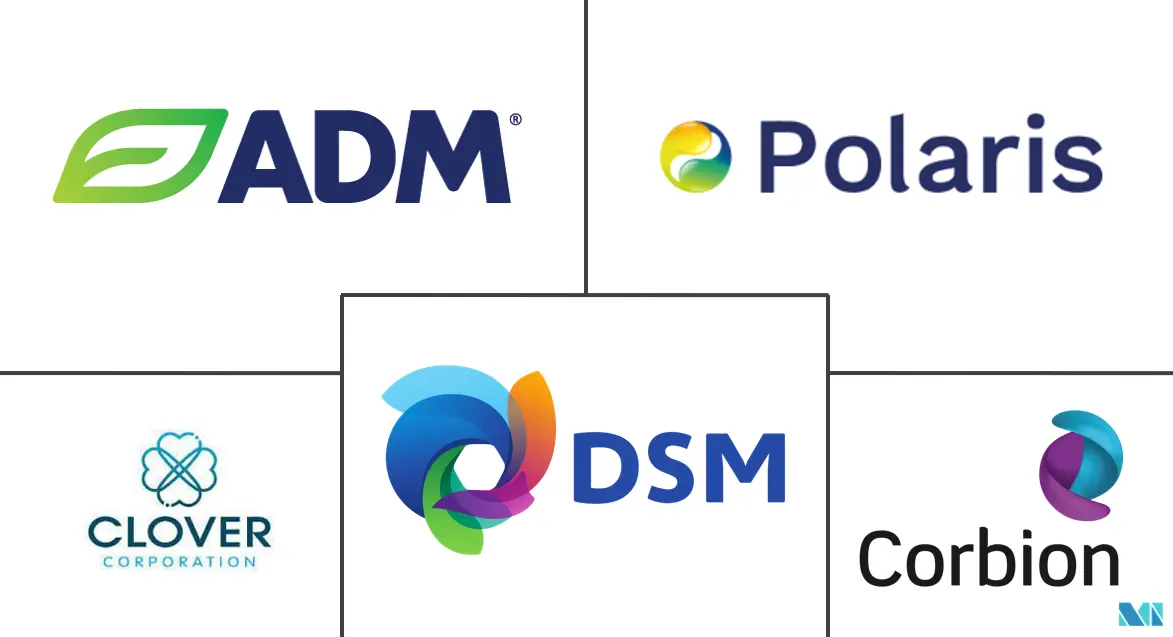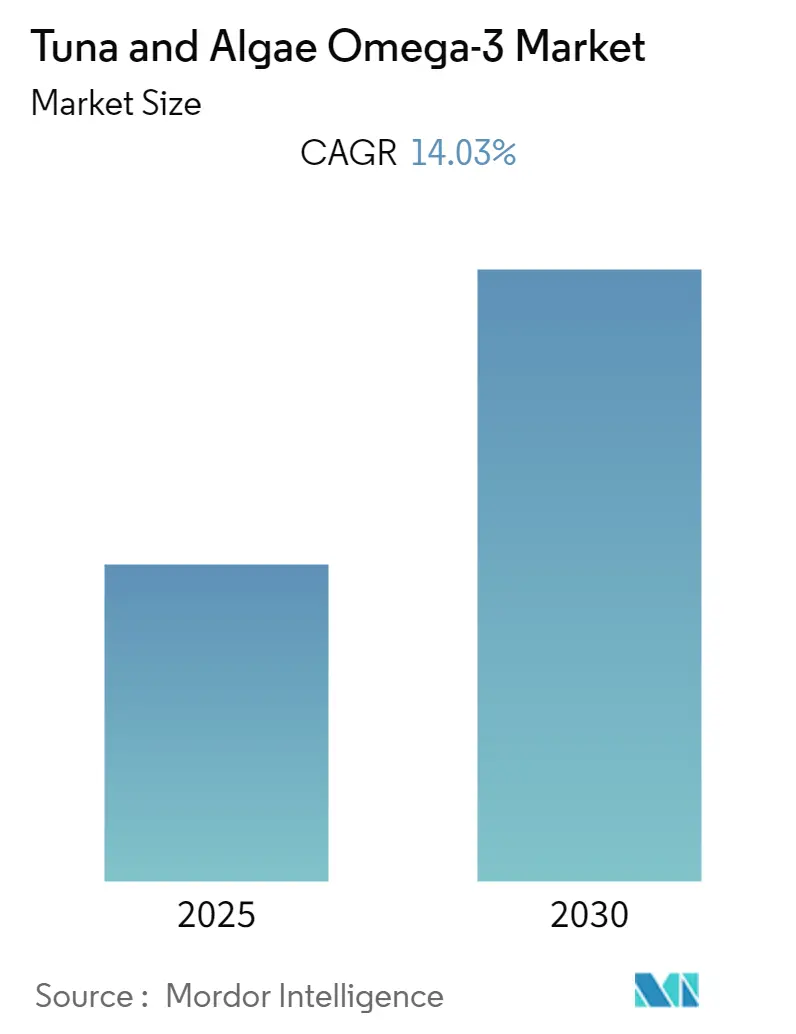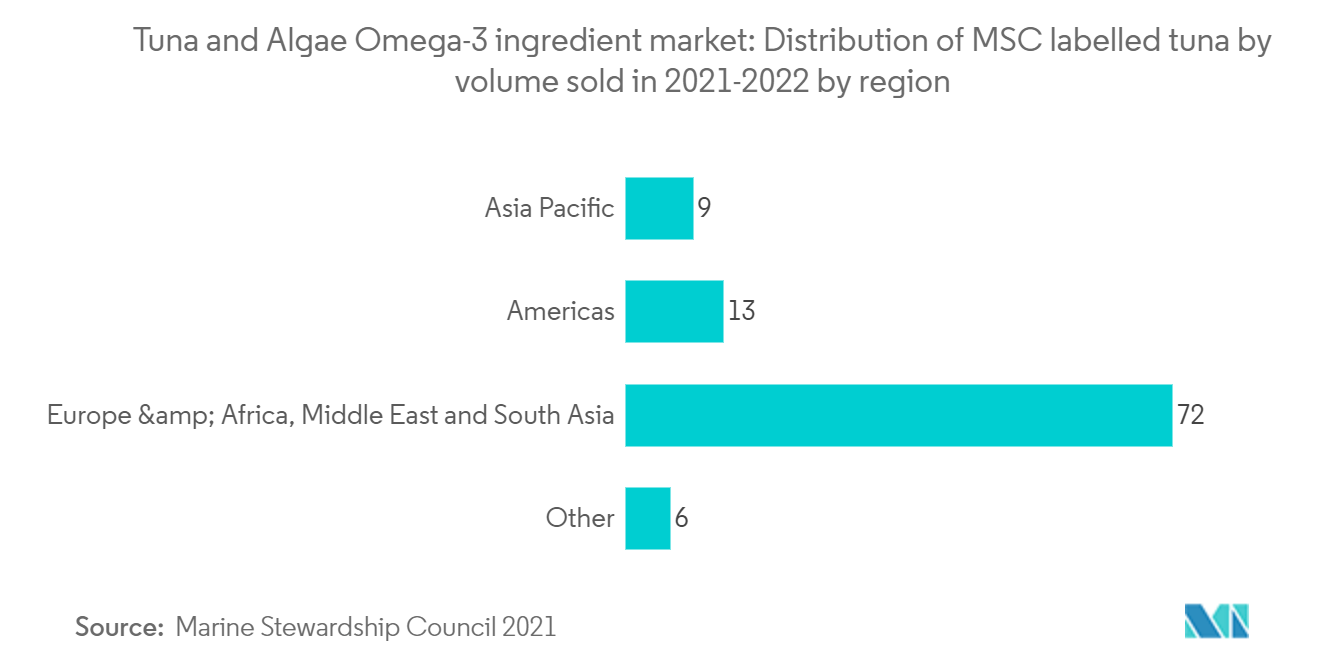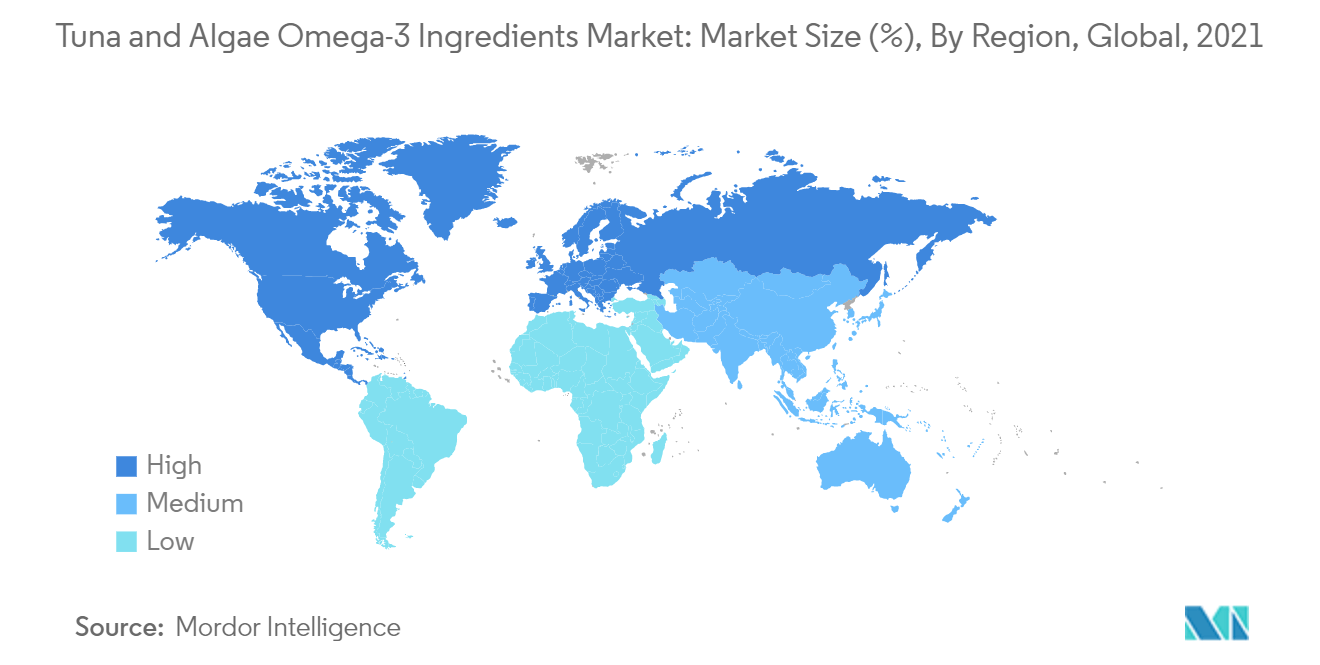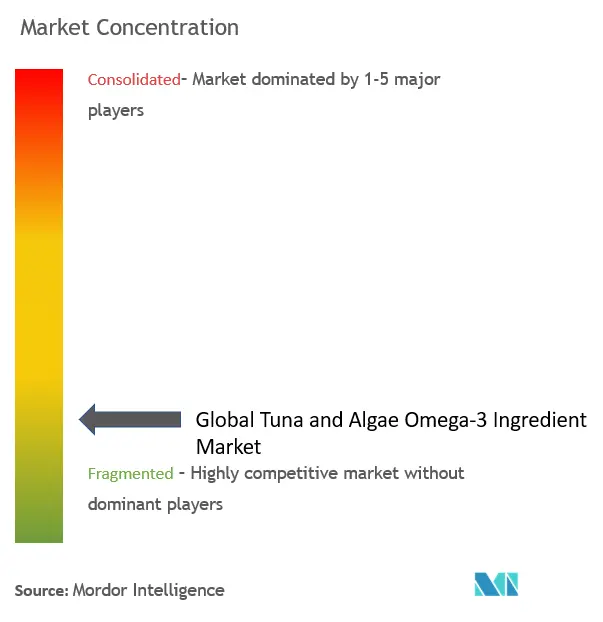Tuna and Algae Omega-3 Ingredient Market Analysis
The Tuna and Algae Omega-3 Market is expected to register a CAGR of 14.03% during the forecast period.
The perceived health benefits of omega-3 fatty acids, for which fish oil is the primary extraction source, drives the demand for tuna omega-3 ingredients. The tuna fish oil omega-3 market has witnessed emerging global raw material hotspots in China, Japan, Spain, and Italy. There has been a surge in the aquaculture sector around the world, and this boost is expected to provide further impetus to the overall growth of the fish oil omega-3 industry. According to the Marine Stewardship Council, the quantity of MSC-certified catch and the number of MSC-certified tuna fisheries continued to increase in 2021 and 2022. Nineteen tuna fisheries received MSC accreditation at the beginning of September 2022, bringing the total to 91.
This resulted in a 24% rise in the amount of MSC-certified tuna catch, from 1,982,000 tonnes in September 2021 to 2,460,000 in September 2022. Nearly 50% of the commercial tuna catch worldwide has MSC certification, boosting the market further. Algae omega-3 ingredients play a key role in driving the overall market growth due to the growing demand for algae omega-3 in infant food fortification, as it provides benefits similar to fish oil and has no off-odor or taste. Additionally, the surge in demand for fortified foods among various age groups across the globe is driving the tuna and omega-3 ingredients market.
Tuna and Algae Omega-3 Ingredient Market Trends
Increasing Consumer Expenditure on Omega-3 Supplements Products
Growing consumer health awareness and concerns toward a healthy lifestyle, majorly in regions like Asia-Pacific, Latin America, and Africa, are leading to an increased demand for ingredients such as EPA and DHA. Moreover, the increase in the percentage of the smoking population, incidences of heart-related complications, and other health-related issues across the world are fueling the growth of omega-3 ingredients, including tuna and algae omega-3 ingredients, especially in developing economies. Manufacturers and suppliers are actively involved in the supply chain of omega-3 in various regions. They are also making strategic efforts to ensure a gradual flow of information regarding the health benefits associated with omega-3 enriched diets, which has largely and positively affected the sales of omega-3 ingredients in developing regions.
Asia-Pacific Emerges as the Largest Market Globally
Driven by the growing demand for sports nutrition and the increase in opportunities for personalized nutrition, omega-3 ingredients hold a promising future market in Asia-Pacific. Moreover, the increasing aging population in the countries such as China and Japan, with a proportionate rise in the general population, is emerging as one of the key factors leading to the demand for brain health supplements, which, in turn, has led many key players to invest on their research and development activities regarding new innovations in omega-3 supplements. The high birth rate and the recent abolition of the one-child policy in China are slated to boost the infant food industry. Many players, such as Pathway International, are strategically partnering with key ingredient manufacturers to expand the production level or product line.
Tuna and Algae Omega-3 Ingredient Industry Overview
The global tuna and algae omega-3 ingredient market is highly fragmented. BASF, Neptune Wellness Solutions Inc., and Omega Protein Corporation are the most active companies in the global tuna and algae omega-3 ingredients market. Key players, like Neptune Wellness Solutions Inc. and Cellana Inc., are focusing on partnerships and joint ventures to increase their production capabilities and consumer base across various regions. Moreover, players are focusing on investing in technology to increase efficiency as well as various research and development activities.
Tuna and Algae Omega-3 Ingredient Market Leaders
-
Archer Daniels Midland Company
-
Koninklijke DSM N.V.
-
Polaris S.A.
-
Clover Corporation Limited
-
Corbion N.V.
- *Disclaimer: Major Players sorted in no particular order
Tuna and Algae Omega-3 Ingredient Market News
- February 2022: Polaris partnered with Golden Omega USA to distribute its algae oils across North America.
- January 2022: AlgaeCytes agreed to a EUR 5 million funding round with German private equity provider IBG Risikokapitalfonds III GmbH & Co. KG (IBG), alongside a EUR 11 million commitment from the German Federal Ministry for Economic Affairs and Energy's GRW investment program. The agreed funding will be used by AlgaeCytes Germany to build one of Europe's largest bioreactors facility in Dessau, Saxony-Anhalt.
- June 2021: Polaris launched the Omegavie DHA 800 algae oil sourced from microalgae (Schizochytrium sp.) that is rich in vitamins, proteins, pigments, and enzymes. The ingredient offers a plant-based and sustainable origin for polyunsaturated fatty acids (PUFAs). It is produced in France and uses Polaris' patented Qualitysilver technology to protect and improve the stability of microalgae. Omegavie DHA 800 is unique because of its high potency, offering a minimum of 800 mg/g of DHA.
Tuna and Algae Omega-3 Ingredient Industry Segmentation
Tuna and algae omega-3 ingredients contain fatty acids, EPA, and DHA. This enables a convenient intake of significant quantities and the condition for specific use.
The tuna and algae omega-3 ingredient market is segmented by type, application, and geography. On the basis of type, the market is segmented into algae type and tuna type. By application, the market is segmented into food and beverage, dietary supplements, pharmaceuticals, animal nutrition, and clinical nutrition. On the basis of geography, the market is segmented into North America, Europe, Asia-Pacific, South America, and the Middle East and Africa. For each segment, the market sizing and forecasts have been done on the basis of value (in USD million).
| Type | Algae Type | Concentration type | High Concentration |
| Medium Concentration | |||
| Low Concentration | |||
| Tuna Type | Crude Tuna Oil | ||
| Refined Tuna Oil | |||
| Application | Food and Beverage | Infant Formula | |
| Fortified Food and Beverages | |||
| Dietary Supplements | |||
| Pharmaceutical | |||
| Animal Nutrition | |||
| Clinical Nutrition | |||
| Geography | North America | United States | |
| Canada | |||
| Mexico | |||
| Rest of North America | |||
| Europe | Spain | ||
| United Kingdom | |||
| Germany | |||
| France | |||
| Italy | |||
| Russia | |||
| Rest of Europe | |||
| Asia-Pacific | China | ||
| Japan | |||
| India | |||
| Australia | |||
| Rest of Asia-Pacific | |||
| South America | Brazil | ||
| Argentina | |||
| Rest of South America | |||
| Middle East and Africa | South Africa | ||
| United Arab Emirates | |||
| Rest of Middle East and Africa | |||
Tuna and Algae Omega-3 Ingredient Market Research FAQs
What is the current Tuna and Algae Omega-3 Market size?
The Tuna and Algae Omega-3 Market is projected to register a CAGR of 14.03% during the forecast period (2025-2030)
Who are the key players in Tuna and Algae Omega-3 Market?
Archer Daniels Midland Company, Koninklijke DSM N.V., Polaris S.A., Clover Corporation Limited and Corbion N.V. are the major companies operating in the Tuna and Algae Omega-3 Market.
Which is the fastest growing region in Tuna and Algae Omega-3 Market?
North America is estimated to grow at the highest CAGR over the forecast period (2025-2030).
Which region has the biggest share in Tuna and Algae Omega-3 Market?
In 2025, the Asia Pacific accounts for the largest market share in Tuna and Algae Omega-3 Market.
What years does this Tuna and Algae Omega-3 Market cover?
The report covers the Tuna and Algae Omega-3 Market historical market size for years: 2019, 2020, 2021, 2022, 2023 and 2024. The report also forecasts the Tuna and Algae Omega-3 Market size for years: 2025, 2026, 2027, 2028, 2029 and 2030.
Our Best Selling Reports
Tuna and Algae Omega-3 Ingredient Industry Report
Statistics for the 2025 Tuna and Algae Omega-3 market share, size and revenue growth rate, created by Mordor Intelligence™ Industry Reports. Tuna and Algae Omega-3 analysis includes a market forecast outlook for 2025 to 2030 and historical overview. Get a sample of this industry analysis as a free report PDF download.

